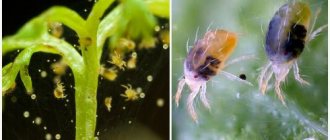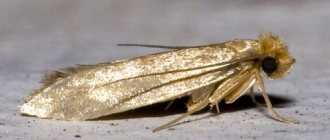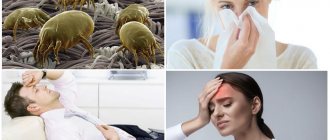Curling leaves, wilting buds, and the plant losing its attractiveness are the first signs of pests. To save the beauty on the windowsill, you need to know how to get rid of aphids on indoor flowers and prevent their appearance in the future. When fighting parasites, it is important to identify and eliminate the causes of the problem, and then destroy the pests using folk remedies or insecticides.
Aphids are a dangerous parasite that quickly adapts to any conditions and in a short time creates large colonies that destroy indoor plants. To save your home greenhouse, it is important to start pest control in a timely manner.
The article contains relevant and effective methods of combating aphids that will help save the plant and restore its attractiveness and vitality.
Description of aphids and how they appear in the house
Aphids are small insects with long legs and a pointed abdomen. The oblong body can be yellow, green, black or pink, but white pests are most often found on indoor plants.
One female aphid can lay up to 100 eggs at a time, which in a couple of weeks turn into adults that destroy flowers. Parasites use their proboscis to suck out the juice from the stems and leaves, depriving the plant of its vitality and attractiveness. In addition, they often spread viral and fungal diseases (sooty fungus). If the necessary measures are not taken in a timely manner, pests quickly adapt to any habitat and form numerous colonies that can destroy all the beauty on the windowsill.
Aphids attack different types of plants, but hyacinths, chrysanthemums, hibiscus, orchids, fuchsias and cyclamens are especially susceptible to attack by pests.
Where can pests appear in the house:
- through open windows and a balcony in the absence of mosquito nets;
- with new flowers (cut or in pots);
- from a person's clothing;
- through the soil used for transplantation;
- The carriers of the larvae can be ants that breed aphids for their own food.
To avoid the spread of aphids from a newly purchased plant to your home ones, keep it in quarantine for several days, and also carry out preventive treatment with special insecticides.
The main reason for the appearance of aphids is dried soil and high indoor temperatures.
Best defense is attack
Prevention will help prevent pests from appearing and multiplying in your home. First of all, carefully examine all suspicious buds and leaves. Sometimes removing them in time can save the flower. Do not keep bouquets close to indoor plants, and remove new flowers in pots from those that have already taken root for a week. Avoid heat and stuffiness, and hang a small net on the windows. A dying plant that can no longer be saved should be thrown away and replaced with fragrant pelargonium, which successfully scares away uninvited guests.
Signs of pests on flowers
Aphids can cause significant damage to plants, so it is important to begin combating the parasites as early as possible. To do this, you need to know the signs of pests in your home greenhouse and periodically inspect each indoor flower for symptoms of disease.
The first manifestations of aphid infestation:
- a sticky layer and tiny punctures appear on the leaves and young shoots;
- flower buds quickly fade and fall off before they have time to bloom;
- the flower loses its attractiveness, withers and dries out;
- leaves darken and curl;
- Ants appear on the windowsill, attracted by the waste products of aphids, which are used by insects as food.
One of the signs of plant infestation by aphids is the appearance of ants. Insects feed on honeydew secreted by parasites, so they are always close to them and can even independently introduce pests to flowers
Signs of a houseplant being affected by aphids
With periodic inspections of flowers, you can notice in time that the plant is sick. External modifications will be visible on it:
- Young shoots wither and curl up.
- A syrupy trail has appeared (produced by pests).
- Blackness has spread - sooty fungus (carried by a parasite).
- Flowers have shrunk or not opened.
- The shape of the buds has changed.
- The presence of a mass accumulation of individuals on the outer side of the leaf.
- Growths have formed on the trunk.
At the initial moment, when there are still few pests, you can notice small punctures on the leaves and the insects themselves. Later they will begin to curl up. Parasites cannot bite through the bark, so they do not settle there.
If an aphid attacks young plants, its death will occur quite quickly. A large colony can stop growth and harm even a more mature flower.
Folk remedies and methods of combating aphids
You can remove aphids from indoor plants yourself using available means. Such methods are easy to use, affordable and absolutely safe for healthy flora, people and pets.
Algorithm for saving indoor plants:
- Isolation of a sick flower, which will protect the rest from infection.
- Preventive spraying of healthy flora.
- Treatment of the affected flower using the chosen method.
Folk remedies for fighting aphids are presented in the table:
| Active substance | Procedure for preparing the composition | Mode of application |
| Celandine | Grind 150 g of dried raw materials or 350 g of fresh herbs and add 1 liter of water. Leave the product in the dark for 24 hours | Spray the plant with the resulting infusion three times at intervals of a day. |
| Wood ash | Mix 50 g of soap, 0.5 l of ash and 10 l of water | Treat the affected leaves and shoots with a filtered solution until the pests are completely destroyed. |
| Garlic | Grind 30 g of garlic in a blender, add 1 liter of water and leave to brew for a day in a dark place. | Treat the flowers with the resulting product three times at intervals of 5 days. |
| Tomato tops | Grind 500 g of raw material, add 1 liter of water and boil for 30 minutes. Add 4 g of liquid soap to the cooled broth | Treat the affected plant until complete recovery. |
| Tobacco | Combine raw materials and water in a 1:2 ratio and let it brew for 2 days. | Dilute the resulting infusion with water and spray the flower. Avoid contact with the soil to avoid damage to the root system. |
| Hot pepper | Grind 50 g of pepper and add 125 ml of water. Boil the mixture for an hour and let it brew for a day | Dilute the filtered infusion in 10 liters of water, use for spraying and watering flowers |
| Orange peels | Pour 100 g of citrus peel with water and let it brew for a couple of days in a warm place | Spray plants affected by aphids |
| Needles | Pour 500 g of pine needles into 2 liters of water and leave for a week, then strain and dilute with water in a ratio of 1:7 | Treat the flower several times with a break of 4 days |
Geranium, dill, parsley, mint or marigold will help fight aphids. Parasites cannot stand the aromas of these plants, so by placing a pot with one of them on the windowsill, you can not only get rid of pests, but also avoid their appearance in the future.
Ladybugs can be used as a biological method of controlling aphids, so do not drive out an insect that has settled on an indoor flower
Types of aphids on flowers
There is no significant difference in the degree of parasitism between different species. They all feed on plant juices and lay eggs on the underside of the leaf. After hatching, the larvae immediately begin to wreck.
Females lay eggs without fertilization. Throughout the warm period of the year, females are born. The family lives on one plant or moves to neighboring ones. At the end of summer, winged individuals are born - females and males. This migratory generation of aphids is capable of moving to any plant and establishing huge colonies in a short time.
Important!
Over the course of several weeks of her life, the female lays about 150 eggs. Each time 40 pieces. The larvae develop in the egg in room conditions in 10 days. They penetrate into the leaf plate, disrupt its integrity, and draw out important substances. In a month, without emergency measures, the plant risks dying.
Different types of aphids clearly differ from each other in body color. Several pests appear on indoor flowers:
- White aphid. Migrating individuals with wings. Dicotyledonous plants are affected; legumes are the most susceptible to attack. The pest overwinters on pistachio trees.
- Green. Apple aphid that attacks pears, plums, and quinces. Overwinters near the buds under the bark.
- Black aphid. Garden aphids, covering several species. Body brown, blue, black. Affects any garden, vegetable crops, decorative flowers.
- Yellow. It affects coniferous trees and lives permanently on their branches. 10 generations are hatched per season. He breaks into the house by accident.
- Bloody. Characterized by a bright red color. Winters on elm. Several generations of wingless individuals grow there, then winged females and males appear and migrate to apple trees.
A photo of the aphid is located below.
Types of aphids
There is no particular point in figuring out which species has captured the home flower. All insects are called aphids; identical methods and methods of control are used. But many people are interested in where pests come from.
Mechanical methods of getting rid of pests
You can save indoor flowers using mechanical cleaning, but this method is effective only at the initial stage of infection. To preserve the plant, remove damaged leaves, buds and shoots and wash it daily under running water. A solution of laundry soap will help to achieve maximum effect. Processing procedure:
- Prepare a soap solution from laundry soap and water in a ratio of 1:6.
- Prepare the necessary attributes, put on rubber gloves.
- Soak a sponge in the solution and thoroughly wipe all leaves, shoots and stems. Avoid getting the product on the soil.
- Rinse the plant with clean running water.
- Repeat the treatment daily until the parasites are completely eliminated.
To mechanically remove aphids, wipe the leaves daily with a damp sponge, remove affected shoots and bathe the flowers under running water.
As an alternative to soap solution, you can use medical alcohol - dissolve 6 tbsp in 1 liter of water. spoons of the product and wipe all the leaves. This composition effectively removes pests and does not damage the leaves, since ammonia quickly evaporates from the surface.
To be sure to get rid of aphids, replace the top part of the soil, where eggs and larvae of pests may be. In this case, choose high-quality soil that has been disinfected or frozen.
Additional tips and tricks
Fighting aphids is a simple process. But the procedure for exterminating pests must follow certain rules:
- Maximum effectiveness can only be achieved by treating all infected areas of the plant. Therefore, it is necessary to thoroughly wipe and spray the foliage, stems and root part of the indoor crop.
- It is better to alternate aphid repellents. This will prevent pests from becoming accustomed to the active component.
- The use of oil solutions is allowed only on the green part of the vegetation. Contact of the product with the buds is prohibited.
- It is necessary to spray flowers in the evening or early in the morning. The room should be damp and cool.
- To enhance the impact of folk remedies, the use of a plastic bag is allowed. After treating the plant with the selected solution, put a bag on it and leave it for several hours.
Aphids on indoor flowers are a common problem for indoor plant lovers. To prevent parasites from destroying crops, they must be removed in a timely manner. Regular examination of flowers will allow you not to miss important time. When the first symptoms are detected, you must immediately take measures to eliminate the insects.
Chemicals for killing parasites
If folk remedies are ineffective, use chemicals. The choice of means depends on the degree of damage and the scale of the disaster. The most effective means include: “Decis”, “Iskra”, “Fitoverm”, “Aktellik”, “Confidor”, “Akarin”, “Karate”.
Spraying flowers with chemicals will help get rid of aphids. When working with insecticides, observe safety precautions and strictly follow the instructions for the product.
Procedure for using chemicals:
- Read the instructions for use of the product.
- Take the recommended safety measures - put on seals and a respirator, remove pets and children from the premises. After handling, wash your hands thoroughly with a concentrated soap solution.
- Wipe the leaves and stems with a sponge soaked in soapy water and then let dry.
- Spray the flower. Carry out the treatment on the balcony on a cloudy day at a temperature of +21…25 ℃, since at a lower temperature the effectiveness of the drug decreases.
- Perform preventive spraying of all plants in the house to prevent aphids from moving onto them.
- Re-treat the flowers several times at intervals of 5-7 days (depending on the recommendations in the instructions).
If the plant cannot be saved, discard it to avoid contaminating other flowers.
Why are aphids dangerous for home flowers?
These insects pose a danger primarily to young plants with tender trunks and leaves. The female parasite lays eggs on the underside of the leaf. After the larvae hatch, they immediately begin sucking the sap from the plant. Deprived of nutrition and moisture, it sheds its buds, withers and dries up within a month.
Honeydew is also dangerous for flowers - the same “milk” secreted by aphids and so loved by ants. It promotes the appearance of sooty fungus, which eventually leads to the death of the plant.
Prevention of aphids
Proper plant care and compliance with the recommended preventive measures will help to avoid the appearance of aphids:
- periodically carry out preventive treatment of plants;
- Make sure to maintain the optimal temperature in the house, as insects settle in a stuffy, poorly ventilated room;
- keep new flowers in quarantine;
- install mosquito nets on all windows in the apartment;
- do not place bouquets of cut flowers (especially chrysanthemums and roses) near indoor plants;
- Soak the new soil for replanting in the cold for several days to destroy the larvae and eggs of pests.
To preserve indoor flowers, provide them with proper care, regularly inspect them to identify pests in a timely manner, and periodically carry out preventive treatment
Maintaining a favorable microclimate in the house, proper care of plants and compliance with preventive measures will help save indoor flowers from aphids. If you were unable to protect them from pests, start fighting when parasites are first detected, preventing the colony from growing. Mechanical treatment, folk remedies and chemicals can help in exterminating insects. The choice of control method depends on the scale of the disaster and individual preferences.
Mr. Summer Resident advises: ways to prevent damage to indoor plants by aphids
Every gardener knows that it is easier to prevent than to remove pests and treat a diseased plant.
It is recommended to carry out a number of preventive measures to prevent aphid infestation:
- Newly purchased flowers need to be quarantined for a while. Be sure to use a warm shower.
- The soil is kept cold (in the freezer) for a short time before planting. You can warm it up in the microwave or bake it in the oven.
- Carry out systematic inspection.
- Provide access to fresh air.
- Moisturize periodically. Sometimes put it under a warm shower.
- Prevent the appearance of ants. If they appear, then treat them.
- Use folk remedies.
Damage caused by aphids
Even one insect can cause enormous damage to potted crops. This is explained by the fact that in just three months the pest produces up to 50 generations of its own kind. This means that plants are literally affected at lightning speed.
Aphids should be removed immediately upon detection. The pest feeds on the juices of the plant, weakening it. As a result, the immune system of green shoots is reduced and the damaged areas create an excellent environment for infections, in particular for sooty fungus. It appears as a dark spot most often on the leaves.
Aphids on violets and other garden and potted crops leave behind a sugary secretion from the juice. It is this that provides a breeding ground for other pathogens.
Mechanical method
The mechanical method of cleaning a bush is effective only if there are very few harmful insects on it. To do this, you need to trim off all the affected parts of the flower if possible, and you should also give it a daily shower until the aphids completely disappear.
The most effective would be a shower using laundry soap, because this pest does not like it at all. It's important to do everything right. First, prepare a soap solution by combining water and soap in a ratio of 6:1. To protect your hands, wear rubber gloves. Moisten a piece of cloth in a soapy solution and wipe the affected buds, shoots and foliage with it, trying to remove all insects. After this, the bush is washed under running water. If necessary, this procedure can be carried out regularly until there are no pests left on the flower. However, make sure that the soap solution does not get into the substrate. During processing, remember that aphid larvae are often found in hard-to-reach places, so you must inspect every leaf and bud, while cutting off and destroying those that have the pest.
Treatment with medical alcohol is also a mechanical method. It cannot damage the sheet plates because it evaporates almost immediately after application.
How to recognize aphids
Recognizing the parasite is quite simple. It largely depends on whether it is a houseplant or a garden plant. But in both cases, the pest can be seen with the naked eye, as well as the consequences of its activities.
Signs of damage to indoor plants
Aphids always hide on the back of the leaf. On flowers, the main signs of colony growth can be considered the following symptoms:
- Not only the leaves, but also the bud and stem will be covered with a dense layer of pests. Due to their small size, it seems that the flower has become fluffy.
- Most often, aphids infect young shoots, green twigs and fresh buds, where the tissues are even more or less fragile and susceptible to negative effects. As a result, they curl up, turn yellow, and then begin to dry out. This is especially noticeable on gladioli, roses and other lush flowering varieties.
- On the stems you can see small droplets that look like dew. These are the remains of sticky juices that the parasite secretes during its life.
- In places where sweet honeydew is located, sooty fungus begins to actively multiply, which looks like dark spots on the surface of the affected stem, leaves or bud.
- When a bud is damaged, it eventually grows defective and ugly.
These signs are quite easy to recognize visually. And already at the first encounter with an insect, you will have to think about treatment and further prevention of aphid infestation.
Many people confuse aphids with whiteflies. In general, they are similar in the way they eat and the results of their life activity. But the signs of whiteflies are different - first a white coating appears, which then turns black due to the developing fungus.
Damage to garden plants
In garden crops, the signs are approximately the same, but with the difference that aphids can be of different types - from ordinary green to black. Due to the open space, they may not be so densely seated on the plant, moving to neighboring areas and trees.
This type of pest loves dark areas with high humidity and heat. Therefore, most often they infect bushes and trees located in the shade, and multiply very quickly in greenhouses. As a result, the green spaces become weak, the leaves and petals on the buds seem underdeveloped and sick, twisted due to incorrect development. Then a fungal infection occurs.











